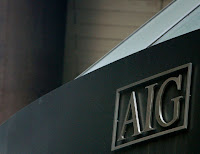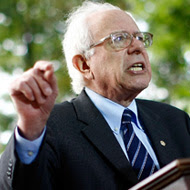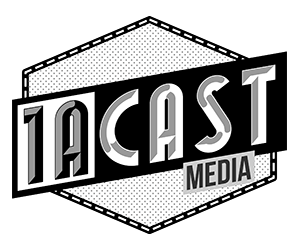The Congress and more specifically, Socialist Bernie Sanders of Vermont pushes Government restrictions aimed to break up Corporations before they become too big too fail. Given that this is hypocrisy since Sanders rushed to rescue both Fannie, Freddie at cost of Billions to taxpayers last year. What is his real motivation?
Only one large corporation today existed in 1900. The capitalist system works and absent outside intervention companies thrive and then fail, to be replaced by others (Joseph A. Schumpeter; “Creative Destruction”). It is interesting that the history of large corporations is that many are spawned by big government. During WWII corporations like GM and Dow Chemical saw their greatest growth as contractors to the Federal Government.
During the past year, thanks largely due to the Federal Reserve, the Treasury, and Congress, three banks— JP Morgan, B of A, and Wells Fargo have similarly grown dramatically now accounting for nearly 1/3 rd of the industry deposits (2yrs ago 20%).
 More recently, we have seen that first hand results of government intervention in the Bank of America takeover of Merrill Lynch, the purchase of Merrill being done at $29/share far in excess of the price at which it should have been consummated. Ken Lewis completed the purchase despite having second thoughts about it due primarily to coercion from Paulson and perhaps Bernanke to finalize the deal to the detriment of B of A’s shareholders. Ultimately, the decision cost Lewis his job.
More recently, we have seen that first hand results of government intervention in the Bank of America takeover of Merrill Lynch, the purchase of Merrill being done at $29/share far in excess of the price at which it should have been consummated. Ken Lewis completed the purchase despite having second thoughts about it due primarily to coercion from Paulson and perhaps Bernanke to finalize the deal to the detriment of B of A’s shareholders. Ultimately, the decision cost Lewis his job.
JPMorgan, Goldman Sachs, and Morgan Stanley were among 9 banks that were persuaded in mid-October 2008 by then Treasury Secretary Henry Paulson to accept TARP funds of $125 billion of capital injections with avowed intention to help restore stability to the financial markets. The three at various times stated they did not need the funds. So why were the funds advanced to them? Seemingly reluctant initially, the government eventually allowed them to payback the TARP funds within a few months
The AIG bail out of last year cost taxpayers some $180 Billion based on the proposition that it was too big to fail. The AIG rescue was predicated on its inability to meet credit default swap obligation to major counter parties inclusive of Goldman Sachs and JP Morgan which in turn whose failure would cause massive systematic risk to the financial system. Of the AIG TARP funds distributed, it is estimated that $50B went to Goldman, something less to JP Morgan the two parties allegedly of most concern to Geithner at that time. Wouldn’t it have been far less costly to simply bail out Goldman and JP Morgan at a cost of $100B than to bail out AIG?
 Peter Wallison in his Wall Street Journal article, “Lack of Candor and the AIG Bailout” (here), dated Nov 27, 2009 points out that Inspector General Neil Barofsky noted that Tim Geithner then President of the NY Fed Bank apparently did not believe that the financial condition of AIG’s credit default swap counterparties was a “relevant factor ” in bailing out AIG. So isn’t it inconsistent for Geithner to now justify the massive AIG bailout, the imposition of draconian restrictions on derivatives, capital requirements of banks and yet at the same time suggest that there was no threat to then AIG CDS counterparties, effectively admitting his decision had nothing to do with systematic risk?
Peter Wallison in his Wall Street Journal article, “Lack of Candor and the AIG Bailout” (here), dated Nov 27, 2009 points out that Inspector General Neil Barofsky noted that Tim Geithner then President of the NY Fed Bank apparently did not believe that the financial condition of AIG’s credit default swap counterparties was a “relevant factor ” in bailing out AIG. So isn’t it inconsistent for Geithner to now justify the massive AIG bailout, the imposition of draconian restrictions on derivatives, capital requirements of banks and yet at the same time suggest that there was no threat to then AIG CDS counterparties, effectively admitting his decision had nothing to do with systematic risk?
The Wall Street Journal in their editorial of September 13, 2009 said it best (here),
“If recent history is any guide, when the feds stage their next intervention, they will not define “systemic risk” and they will refuse to release the data underlying their decision. To this day, taxpayers can only guess at the specific reasons behind the ad hoc rescues that began with Bear Stearns in March of 2008. Now Team Obama seeks to codify the bailout policies of the last 18 months.
 Before receiving authority for new adventures across U.S. commerce, financial regulators should explain their current interventions. The basic questions: How exactly does the government measure systemic risk, and how do regulators know that the U.S. economy can’t live without a particular firm? Americans still don’t know why Bear, Citigroup and AIG were saved, but Lehman wasn’t.”
Before receiving authority for new adventures across U.S. commerce, financial regulators should explain their current interventions. The basic questions: How exactly does the government measure systemic risk, and how do regulators know that the U.S. economy can’t live without a particular firm? Americans still don’t know why Bear, Citigroup and AIG were saved, but Lehman wasn’t.”
On the Seeking Alpha blog, Charles Lieberman suggests that size had nothing to do with the credit crisis,( here)
If corporation size was not the cause of crisis, if several large financial firms were unlikely to fail without TARP funds, if the Treasury Secretary then the head of the NY Fed was unconcerned about systematic risk, then why the rush to bail out those Too Big Too Fail? Why the rush to break up larger firms?
Does this amendment allow the Federal Government to become the largest predator in the country, whose main objective seems to be more aligned with its own survival and the expansion rather than to expand competition in the economy? Is this legislation simply another attempt to deliver additional leverage to the Federal Government to exert control over the private sector and thus shaping the economy in its own image, regardless of the choice of the electorate, the taxpayers and consumers? Given the apparent lack of logic in the Federal Government’s choice of winners and losers over the past year, how would the proposed amendment benefit the economy?
And why if Senator Sanders is truly serious about preemptively breaking up firms that are “Too Big Too Fail” wouldn’t he be actively seeking the break up and replacement Fannie Mae and Freddie Mac, who along with the FHA currently account for nearly 90% of all residential mortgage lending and 40% of all apartment lending? Instead Sanders, Congress, the Federal Housing Financing Agency and the Treasury are re-negotiating to extend the GSE’s government financing plan under more favorable terms
Tell ’em where you saw it. Http://www.victoriataft.com




